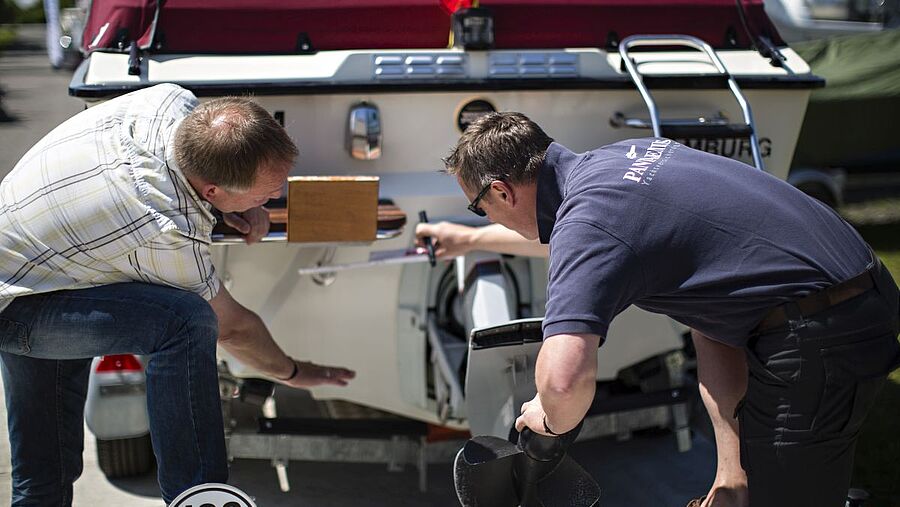
* Pantaenius UK Limited is authorised and regulated by the Financial Conduct Authority (Authorised No.308688)
As with a car, the yacht's engine system should be maintained, regularly serviced and made fit for the cold weather in winter. Unlike with road vehicles or in professional sailing, there are no standards agencies checking for defects with recreational sailing. This is no reason to neglect your engine system, whether you have a motorboat or sailing boat. Use the winter months to avoid any nasty surprises in the spring.

With every engine it is advisable to change the oil at least once per year, as contaminated oil can damage the engine and cause the piston to seize up. It is a good idea to change the filter at the same time. After changing the oil and oil filter, boat owners should focus on the cooling system. The seawater filter insert must be cleaned and the seal inserted with an acid-free lubricant or Vaseline. The impeller, which has spent the winter wrapped in clean cloth, after first being rubbed with glycerol, is put in the pump housing together with the shaft. Do not forget to check the coolant (dual-circuit cooling) and refill if necessary. Machines with a simple cooling circuit must be completely submerged in water during winter storage and rinsed with freshwater. We recommend you then apply a preserver, made from a mixture of water and antifreeze, in order to prevent frost damage and corrosion. When working with dual-circuit cooling, the seawater should also be emptied and filled with antifreeze. The antifreeze concentration of the inner circuit must be checked regularly. This also applies to engines with an exterior cooling system. In certain circumstances, the mixture must be adapted to accommodate the expected winter temperatures.
If possible, leave the fuel in the tank during winter!
When filling and refilling the antifreeze, you must note for both the inner and outer circuits that the engine must be started in order to run the liquid into the circuit. It is therefore advisable to fill the antifreeze while the boat is still in the water.
Depending on the hours of operation, the toothed belt should be checked once or twice per year and, if need be, retensioned. If the belt is damaged it must be replaced. This is because a defective V-belt can lead to the battery above the alternator not being charged, the seawater pump for the cooling system failing and the power steering pump not working.
Owners with a sterndrive or saildrive must regularly replace the sealing gaskets, as they are either partially or fully submerged in the water and saltwater can cause them to quickly become brittle and fragile. The manufacturer's operating instructions regarding the gasket operating life should be taken very seriously. Porous sealing gaskets have often led to water ingress in the past. In the worst case, the ship might even sink. You should also remove the propeller, lubricate the shaft and clean the propeller. For boats with a shaft system, it is also important to check the shaft play in the stern tube and on the shaft support. In addition, the gear oil should be let out and replaced with fresh oil. The sacrificial anodes should also be checked and replaced if worn. Be aware that there are different anodes for saltwater and freshwater. If you are unsure, contact a reliable service company. Just like with cars, every manufacturer has their own main branch, but also has independent service centres that can be found in most marinas and can help with most engines.
The fuel tanks are also important, especially the diesel tanks: they must always be drained of water in winter. Older boats in particular have a draining pipe which can be used to drain the water that collects at the base of the tank. New yachts often do not have this pipe, however, so the water must be suctioned off with a hose. All filters and filter inserts must then be replaced as a precaution.
An often debated question is whether the fuel tank should be emptied for winter storage or left full. It is definitely better for the ship if the fuel remains in the tank, as this prevents flammable gases and condensation from building up, and the petrol helps prevent corrosion. However, before making this decision, you must check with the winter storage operator whether this is permitted. Many sites only allow a limited amount of fuel to be stored. If the fuel is allowed to remain in the tank, it should be mixed with a fuel additive. The additive dissolves deposits in the tank and binds moisture and is later simply burnt off with the fuel. The additive should be added before the yacht is put in winter storage and should be dispersed with the engine running to allow it to release its conserving properties.